It's Monk's Time! With the Unique Thelonious Monk
A critical look at the first decade of his recorded legacy, a deep dive into three of his greatest tracks and further recommendations
Monk was born on October 10, 1917 in Rocky Mount, North Carolina. Four years later his family moved to New York City, settling at the Phipps Houses at 243 West 63rd St in Manhattan, known then as the San Juan Hill area, later referred to as the Lincoln Center for the Performing Arts neighborhood. When he was five years old, a neighbor gave him piano lessons in the stride style of Fats Waller and James P Johnson. At ages 10-12 he had classical piano lessons from Simon Wolf, a pianist and violinist who had studied under Alfred Megerin, the concertmaster of the New York Philharmonic. Monk learned to play pieces by Bach, Beethoven and Mozart, but his favorites were Chopin and Rachmaninoff.
Early Recordings
Minton's Playhouse in Harlem was a breeding ground for the style that became known as bebop, later called simply bop. Monk then was accomplished enough to be the Minton house pianist where he played with such well known musicians as Charlie Parker, Dizzy Gillespie, Max Roach, Kenny Clarke and Charlie Christian. There were also after hours sessions that attracted players such as Miles Davis, Art Blakey, Fats Navarro and Dexter Gordon. It is likely Monk played with all of these. But this new genre of jazz, known for its fast tempi and chord changes frequently based on standards was not the direction Monk was to pursue. In a 1948 interview with critic George T. Simon, he was critical of other bebop musicians stating, "I like to make up my own chords and melodies....My time will come" And he predicted the records he had just cut for Blue Note under his own leadership would make that happen.
Blue Note 1947--1952
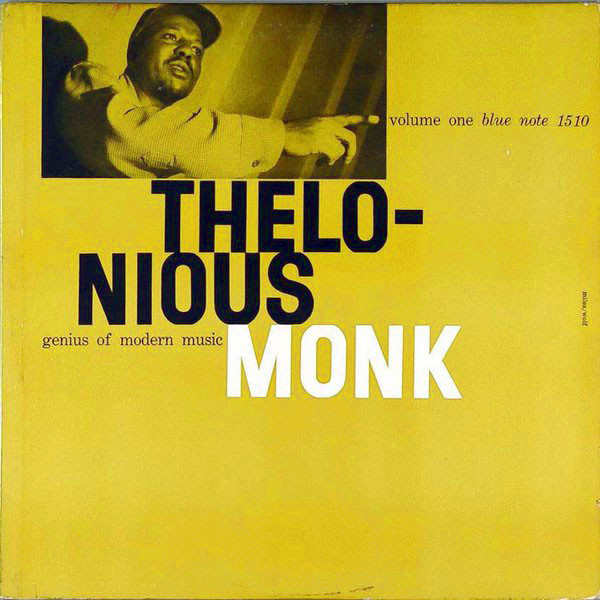 Compilation of tracks recorded in October and November 1947 released on LP in 1956.
Compilation of tracks recorded in October and November 1947 released on LP in 1956.
Listening to some of Monk's very few existing recordings at Minton's it is not apparent that something very special was about to happen. For the most part he is providing standard accompaniment. But Albert Lion, the president of Blue Note records must have had an unusually good ear to suss out something in Monk. It is possible he heard two solo piano Monk recordings, of "Round Midnight" and "These Foolish Things" from 1944. These were recorded at Baron Timme Rosenkrantz's home and finally saw the light of day when Storyville Records released them on a compilation CD in 2015.The Cootie Williams orchestra also recorded "Round Midnight" in 1944 so it's possible Lion also heard this.
Anyone hearing the sublime melodies of this Monk composition smack dab in the middle of the bop years would have known a major talent was lurking. He proceeded to give Monk his first recording sessions as a leader in 1947. In three days, two in October and one in November, Monk cut 16 tracks and 5 alternates. Many of these, such as the gorgeous "Ruby My Dear," " In Walked Bud" and his most famous song, "Round Midnight" have since become standards. These were not based on traditional harmonic progressions nor were they furious bop forays, which were sometimes bewildering to both the public and older musicians. Rather they had melodies, and Monk was improvising on the melodies, not the chord progressions. And what melodies they were! Just beautiful with Monk injecting his unique timing, space and dissonance into his improvisations. Some of these 16 songs were collected on a 10" LP issued in 1951 and more of them reissued on a 12" LP in 1955 titled Genius of Modern Music. One of these, "Misterioso," is selected here for a deeper dive. It was recorded on July 2,1948, The four songs from that session,,,, "Misterioso," "Evidence," " Epistrophy" and "I Mean You" constitute one of Monk's most successful dates as a leader.
"Misterioso"
I must have heard this original version of "Misterioso" at least 50 times and it never fails to thrill me. It doesn't hurt to have the great Milt Jackson on vibes, a musician with an excellent feeling for Monk's unique compositions. Glorious dissonance, that's how I would describe parts of this song. Notice the chord at 1:45. Probably unpleasant to some ears, but to Monk it sounds so right he plays it three more times. The note at 2:04 leads to the thrilling, unsettling chord at 2:08. At the end of Monk's solo 2:34-2:39 he doesn't play what most people would expect the logical conclusion to be. Instead, a stutter-step surprise. Beginning at 2:40 Monk splashes notes with percussive force, like a hard rain hitting the pavement. His choice of exactly when to hit these notes is an example of Monk's genius, capped by a perfectly timed last hammer at 2:59. Monk lays out from 2:59-3:02, his sense of space is impeccable.
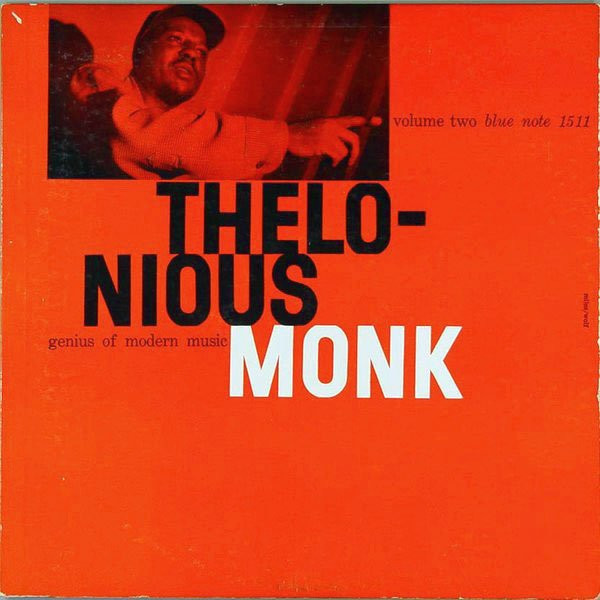 Originally released on Blue Note in 1956.
Originally released on Blue Note in 1956.
Genius Of Modern Music Vol 2 picks up where Vol 1 leaves off. The album consists of two recording dates in 1951 and 1952. Another success, it includes such Monk staples as "Criss Cross," "Eronel," "Ask Me Now" "Straight, No Chaser," and "Let's Cool One," as well as the standards "Nice Work If You Can Get It," "Willow Weep For Me" and "Carolina Moon." The horn players on this LP are Sahib Shihab, Kenny Dorham, Lou Donaldson and Lucky Thompson. Monk is in fine form throughout, and along with Vol.1 these two LP's showcase the earliest foundation recordings of this seminal musician and as such are mandatory for any serious jazz collection.
Prestige 1952-1954
After Monk left Blue Note he signed to Prestige, resulting in three albums worth of songs with different backing musicians. These albums are still not fully appreciated today, even though all the musicianship is top tier with many Monk classics heard for the first time.
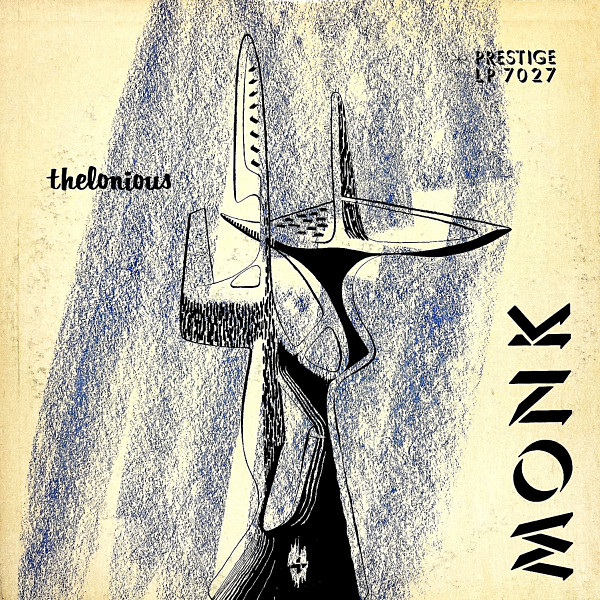 Originally recorded on two 10" LP's, later issued on one 12" LP in 1954.
Originally recorded on two 10" LP's, later issued on one 12" LP in 1954.
Known as Thelonious Monk Trio, this album sounds just as fresh today as it did 70 years ago. The LP consists of three different trios. The first with Gary Mapp on bass and Art Blakey on drums recorded four songs in October, 1952. The second with Gary Mapp and Max Roach on drums recorded four songs in December, 1952 and the third with Percy Heath on bass and Art Blakey recorded one song in December, 1954. At this date, Monk also recorded a solo version of "Just A Gigolo" which is included on the album. The sound the recording engineers, Rudy Van Gelder and Les Kahan got from these trios is vibrant with Monk's unorthodox attack quite apparent. Most pianists play with arched fingers but Monk plays with flat, horizontal fingers. This produces a dynamic, percussive sound, which is not to say Monk can't play delicate runs as well as anyone; he can and does. Filled with classic Monk compositions heard for the first time such as "Little Rootie Tootie," "Bye-Ya," "Monk's Dream," "Trinkle Tinkle" and the wonderful "Blue Monk," this is a must have album if you love Monk.
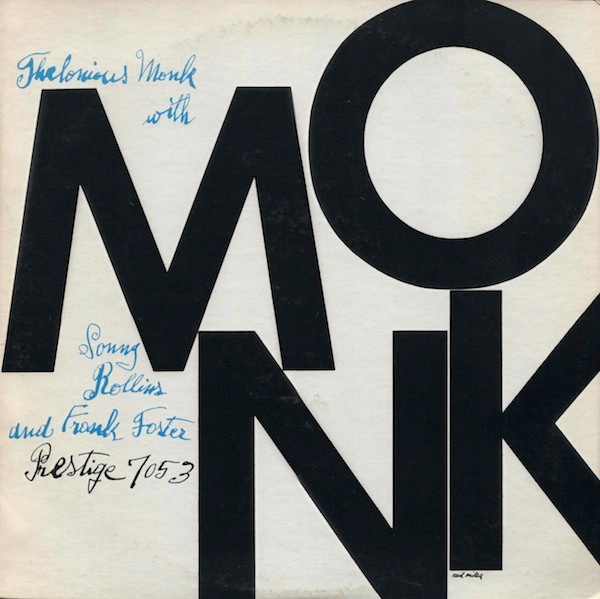 Compilation of two 10" LP's later issued on one 12" LP in 1956
Compilation of two 10" LP's later issued on one 12" LP in 1956
Commonly known as Thelonious Monk Quintet, this album consists of two quintets. The first, recorded in 1953, has Sonny Rollins, tenor sax, Julius Watkins, French horn, Percy Heath, bass and Willie Jones, drums. But the highlights are the four tracks with Frank Foster, tenor sax, Ray Copeland, trumpet, Curly Russell, bass and Art Blakey, drums. They play on "We See," a bright, bouncy composition, "Locomotive," with its trainlike feeling , "Hackensack" and the lovely standard "Smoke Gets In Your Eyes."
"Smoke Gets In Your Eyes"
A unique interpretation of "Smoke Gets In Your Eyes". His playing is immediately identifiable. No one sounded like Monk, his timing, his spacing, his chords, his dissonance. Here he turns this revered old chestnut into a composition by splitting up the melody between horns and piano. The chord at 0:25 is striking in its bluntness and originality, and Monk hammers it home again and again.
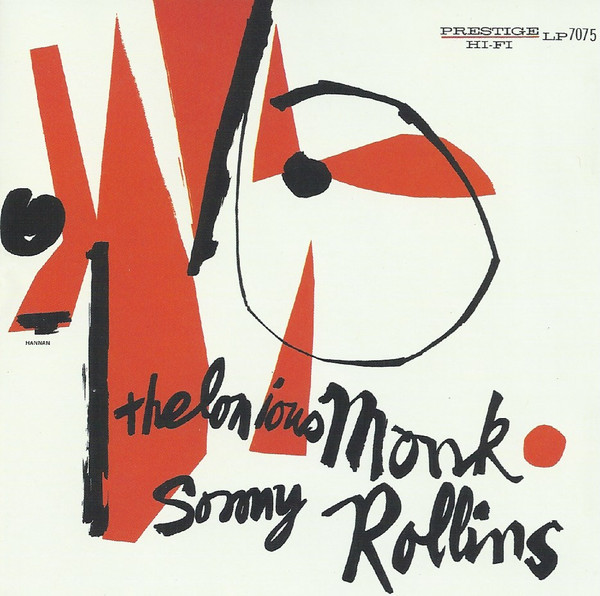 Compilation of quintet, quartet and trio tracks recorded in 1953 and 1954.relased on a 12" LP in 1956.
Compilation of quintet, quartet and trio tracks recorded in 1953 and 1954.relased on a 12" LP in 1956.
The two quartet tracks," I Want To Be Happy" and "The Way You Look Tonight" with Sonny Rollins, tenor sax, Tommy Potter, bass and Art Taylor, drums, are standards essentially showcasing Rollins, although the later has a fine Monk solo. "Friday the 13th," a famous Monk song heard here for the first time, is ten minutes long but with only lukewarm results. I found the playing of Sonny Rollins and Julius Watkins, French horn, largely uninspired with Willie Jones' drumming pretty much the same. Percy Heath is solid on bass and even though Monk's first solo starts out slowly, he soon hits his stride, his shower of dissonance at the end reminding everyone of Monk at his best.
Far better are the two trio tracks with Percy Heath, bass and Art Blakey, drums. "Nutty" is one of Monk's most enduring and catchy compositions with Monk returning to it many times over the years with different groups. The other trio track, "Work," which I must admit to not liking on first hearing, is sparse and angular, with only a slight melody. Just a few years ago I read that Thelonious Monk Jr., Monk's son who is a famous jazz drummer in his own right, could not really understand his father's music for quite awhile. Then one day he listened to "Work" and finally he understood. And now I do too. It is archetypal sparse Monk with Art Blakey's solo an added treat.
A quick trip to Paris, France in 1954
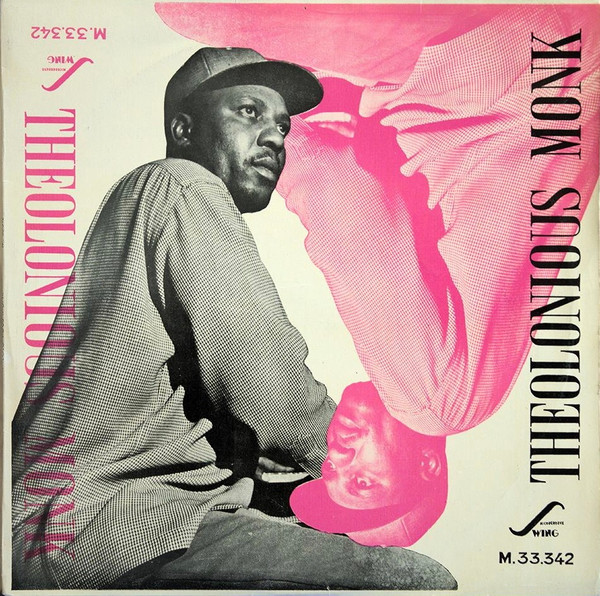 Titled Thelonious Monk Piano Solo on a 10" LP recorded June 4, 1954 released on Vogue, Swing. Later released on various LP's.
Titled Thelonious Monk Piano Solo on a 10" LP recorded June 4, 1954 released on Vogue, Swing. Later released on various LP's.
A little known but fascinating 10" LP of seven Monk originals and one standard, "Smoke Gets In Your Eyes." All the originals have been recorded before but not in a solo piano setting. Of particular interest is a five minute solo version of "Round Midnight." Other famous Monk songs here are "Off Minor," "Well You Needn't" and "Reflections." Except for "Round Midnight," all the track are short, ranging from 2 1/2 to 3 1/2 minutes so everything has to count, like a musician cutting a 78 RPM record.
Riverside Records 1956-1961
Although many of Monk's earliest recordings are of a very high caliber, holding up remarkably well and sounding as fresh today as the day they were recorded, by 1954 commercial success still eluded Monk. Part of this was due to Prestige which did a poor job promoting Monk. But I think it was mostly because of the aura that surrounded Monk. He was still called "the high priest of bop" with all the mystical nonsense surrounding that term even though Monk's direction was certainly not bop. Monk was not a talkative person and hardly gave interviews, let alone talk about his music. He also refused to bend his music to make it more palatable for the public. This ongoing shroud of mystery must have been strange to him since I would have thought his music would appeal to a much larger audience. After all, Monk improvised on the melody in songs, not the chord changes as did most other jazz musicians. Everyone can follow a good melody and hear what Monk was doing with it. But that was not the case and Monk was still scrambling to make a living.
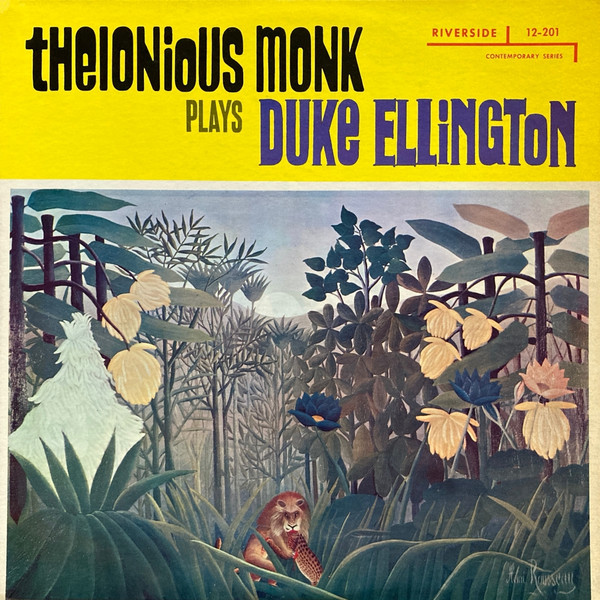 Originally released in 1956 with a different cover and titled Thelonious Monk Plays The Music Of Duke Ellington. Released in 1958, this is the better known cover with a painting by Henri Rousseau.
Originally released in 1956 with a different cover and titled Thelonious Monk Plays The Music Of Duke Ellington. Released in 1958, this is the better known cover with a painting by Henri Rousseau.
Riverside Records knew they had a "difficult" artist on their hands when they signed Monk. In an effort to make him more relatable to the public, they chose to have him play all Ellington songs for his debut LP. And as we will see next, all standards for his sophomore effort. In retrospect I think this was a smart move by the label. Hitting the buying public with all Monk compositions right off the bat would have resulted in much the same lackluster sales.
The album got mostly good reviews and I would guess sold reasonably well, although figures are hard to come by today. The accompaniment by Oscar Pettiford on bass is outstanding and Kenny Clarke on drums is rock solid. Monk is in good form and the album is pleasant. But nothing really jumps out and smacks you over the head. Ellington's compositions are the most played in jazz and Monk's are the second most played. Tracks like "I let a Song Go Out of My Heart," "Mood Indigo," "Caravan," "I Got It Bad (And that Ain't Good)" and "Sophisticated Lady" are all dearly loved classics. So this should have been a complete success. But it lacks spark Monk has stated that Ellington was one of his biggest influences and here Monk is too reverential towards Duke. Too much Ellington, not enough Monk for me. Riverside's strategy to make Monk more accessible only neutralized what made Monk so unique. That said, the album does have its fans.
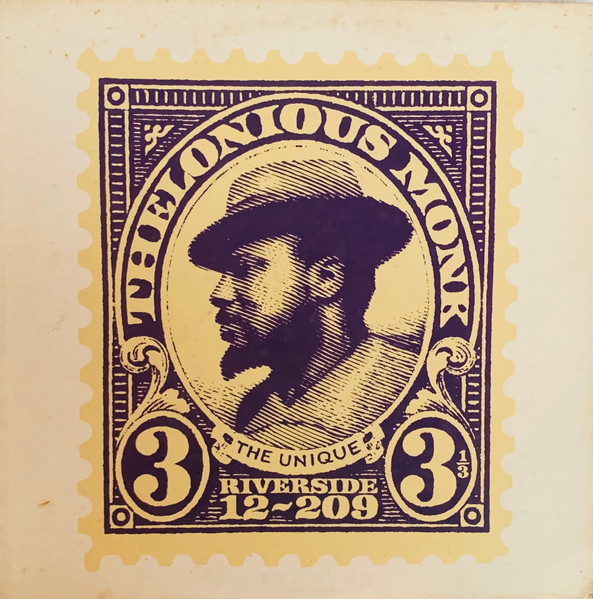 Originally released with a different cover in 1956. This cover is the better known one from 1958.
Originally released with a different cover in 1956. This cover is the better known one from 1958.
Riverside was still trying to ease Monk in with their choice of an all standards album. More successful than the Ellington LP, here Monk puts his own personal stamp on many of these songs. In other words, Monk fans should like this one. All seven tracks have forceful playing from Monk, Oscar Pettiford, bass and Art Blakey, drums. Really, Pettiford and Blakey are outstanding behind Monk. IMO Blakey was the best drummer for Monk--he adds wonderful touches on all the songs.. Some standout tracks are "Tea For Two" where Pettiford adds both plucking and bowing after Monk's intro. Then Monk launches into a wry, dissonant, old fashioned style of piano playing, the kind the "square" public would probably appreciate. "Memories Of You" is the one solo piano track and Monk shines here. It contains one of Monk's most striking touches, playing a chord and then quickly releasing all the notes except one so that note can most effectively represent the chord. "Honeysuckle Rose" and the closing seven minute track, "Just You, Just Me" are also excellent
I've heard all Monk's Riverside albums multiple times. If I were to pick one album to introduce a new, a somewhat hesitant listener to Monk, I would choose The Unique Thelonious Monk. The first pressing of the album contained a sheet of Monk stamps like those pictured on the album cover. Some actually made their way onto envelopes and were sent through the mail.
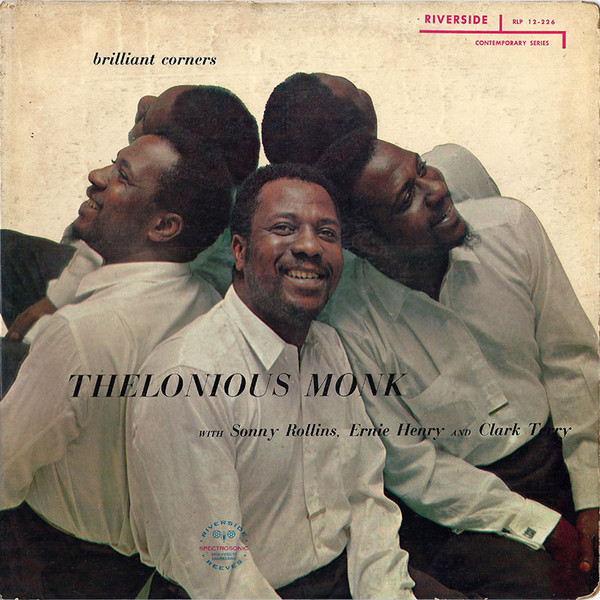 Released in 1957.
Released in 1957.
Monk's third album for Riverside is a total success. The shackles, so to speak, were taken off Monk and he responded with an all time great jazz album.. Sonny Rollins, tenor sax, Ernie Henry, alto sax, Oscar Pettiford, bass and Max Roach, drums, play on three of the tracks. Clark Terry, trumpet and Paul Chambers, bass, play on the closing track, "Bemsha Swing." Four wonderful Monk compositions were heard for the first time on record plus one solo piano track, "I Surrender, Dear."
Some highlights from the album. The opening track, "Brilliant Corners," a song so difficult to play that the final album version had to be spliced together from various takes. On one take, the recording engineer did not hear Pettiford's bass although he saw Pettiford playing. Turns out Pettiford was so exasperated he was just miming playing the bass. "Ba-Lue Bolivar Ba Lues-Are," a long, 13 minute bluesy track with excellent playing by all. " Pannonica" is named for Baroness Nica De Koenigswarter, a long time friend and patron. Monk happened to find a celeste in the studio which he set up at a right angle to the piano. At times he plays only the piano, at other times only the celeste. And, at one point, he plays both at the same time, creating one of the most sublime moments in all of Monk's music. "Bemsha Swing," closing the LP, is a thunderous track featuring an outstanding Max Roach on tympani.
"I Surrender, Dear"
The lone solo piano track is extraordinary. Only Monk could create something like this.
The exciting chords at 0:15, 0:43 and 1:37 are brought to a climax at 2:20, 2:24, 2:27 and 2:31 with explosive force to create a riveting sound. The run from 2:44--3:20 with its jagged tempos and piercing dissonance is Monk at his finest. No one played like this. A lovely little stride break at 3:45. A perfect one beat pause at 4:25. Then the fireworks start. The chords at 4:52 and 4:56 are stunning in their intensity, especially the last with its two note exclamation point. Can't go higher than this, so the final two chords are slightly diminished at 5:01 and 5:05. And Monk plays such a sweet little ending, although always with a Monk edge to it.
Further Riverside Recommendations
Monk recorded 15 albums for Riverside. They range from OK to excellent. The following are my favorites and some I do not care for.
Thelonious Himself 1957
A masterpiece. All solo piano except for the last track, which adds Wilber Ware on bass and John Coltrane on tenor sax. Monk in a melancholy, reflective mood and the standards such as "I Should Care," "April In Paris," "I'm Getting Sentimental Over You" and "Ghost of a Chance" never sounded so meditative and heartfelt. The over 6 1/2 minute "Round Midnight": is the definitive version of Monk's most famous song and alone is worth the price of admission. Then there's the 9 minute original "Functional." After hearing it played back in the studio Monk remarked ''I sound like James P. Johnson." (The famous Harlem stride pianist and composer.) The big surprise here is the final track, "Monk's Mood." When I first heard the album I assumed it was all solo piano as I'm sure most listeners did. I almost jumped out of my chair when I heard Ware's slow walking bass come in. And then Trane! One of the most electrifying moments I've had listening to music.
In early 1957 Coltrane began visiting Monk's apartment.
“We’d already recorded one song, ‘Monk’s Mood,’ and I liked it so well,” So he invited me around, then I started learning all of his tunes . . . I’d go by his apartment, and get him out of bed [laughs] — he’d wake up and roll over to the piano and start playing . . . he would stop and show me some parts that were pretty difficult, and if I had a lot of trouble, well, he’d get his portfolio out show me the music . . . sometimes, we’d get just one tune a day. Maybe.”“Working with Monk brought me close to a musical architect of the highest order. I felt I learned from him in every way – through the senses, theoretically, technically. I would talk to Monk about musical problems, and he would sit at the piano and show me the answers just by playing them. I could watch him play and find out the things that I wanted to know. Also, I could see a lot of things that I didn’t know about at all.” – John Coltrane, Down Beat 1960
Monk's Music 1957
Another masterpiece with the iconic cover photo of Monk decked out in a suit, cap and sunglasses seated in a child's red wagon. Who other than Monk would begin a classic jazz album with a one minute hymn "Abide With Me," played by only three horns? Then comes "Well, You Needn't," "Ruby My Dear," "Off Minor," "Epistrophy" and "Crepuscule With Nellie" (Monk's wife). Some of Monk's most beloved songs given an outstanding treatment. The album is a septet--Monk on piano, Ray Copeland, trumpet, Gigi Gryce, alto sax, John Coltrane and Colman Hawkins. tenor saxes, Wilber Ware, bass and Art Blakey, drums. Monk was obviously in great spirits in the studio. He was reuniting with two old friends, Hawkins and Gryce. The former had given Monk his first ever recoding date in 1944 with the Coleman Hawkins quartet and Gryce had employed Monk as his pianist on four songs, three of them Monk originals, in 1955. These were compiled on the Gryce album Nica's Tempo. It is worth noting that these three Monk songs were almost never recorded again by Monk. Monk's playing on Monk's Music has never been more assertive --he just jumps out of the speakers. On "Epistrophy," Hawk makes two false starts. Did Monk say "Cut!" and start another take, as almost every other musician would do?. No, he keeps the take on the record. And you know what? It only enhances the immediacy of the music and does not detract one bit. This is a very exciting record! The quartet "Ruby My Dear," with just Hawkins on tenor is simply gorgeous. Monk, knowing Hawkins is into something special, plays the shortest solo I've ever heard from him (30 seconds) before handing it back to Hawk. I've gotten flak before for saying this but I think this version cuts the one with Monk and Trane. Hawk has a perfect feeling for the deepest emotional core of this song.
One last thing. I feel a septet is the perfect sound for Monk's compositions, and a trumpet the perfect instrument for Monk's angular songs. The trio of albums, Brilliant Corners, Thelonious Himself and Monk's Music remain my three favorite Monk albums.
Thelonious In Action 1958 and Misterioso 1958
Monk's gig at the Five Spot here in New York City must have been very satisfying for him, finding steady work again. The resulting two live albums recorded there find Monk in a happy upbeat mood resulting in extremely energetic playing throughout. Johnny Griffin, only 30 years old at the time, had just replaced Coltrane in Monk's working quartet. Griffin could play any style of music and at lightning speed if necessary and his deep, rich tone fits well with Monk. How you react to these albums will depend on how you view Griffin. He plays a lot of notes on many of these songs. Some might feel he's going off the deep end. But his sheer exuberance matches Monk's and together they create a rush that carries the day for me. Ahmed-Abdul Malik on bass and Roy Haynes on drums anchor the fireworks. If, like me, you sometimes want to close your eyes and pretend you're in a club listening to jazz with all the clinking of glasses and background noises, you will certainly enjoy these two LP's.
5 By Monk By 5 1959
Thad Jones, cornet, Charlie Rouse, tenor sax, Monk, piano, Sam Jones, bass, Art Taylor, drums.
One of Monk's best Riverside recordings. Charlie Rouse, Monk's longtime tenor saxophonist, makes his first appearance on record with Monk. Five Monk originals, including two very catchy ones are heard here for the first time---"Jackie-ing" and "Played Twice." I would rate this, along with Brilliant Corners and Monk's Music, as his three best albums with instrumentation larger than a quartet.
Thelonious Alone In San Francisco 1959
Slightly more upbeat than Thelonious Himself, this all solo piano recording is wonderful too. Do you want to chill out on a hot summer's day listening to music or cuddle with your main squeeze on a cold winter's night? Romantic and relaxing, penetrating straight to your heart, Thelonious Himself and Thelonious Alone In San Francisco will be the perfect additions.
On the downside
Mulligan Meets Monk 1957
Gerry Mulligan, baritone sax, Monk, piano, Wilber Ware, bass, Shadow Wilson, drums.
Mulligan and Monk had known each other for years and when John Coltrane was unavailable at the last minute to record with Monk, someone at Riverside thought of pairing the two friends. With these two giants of jazz recording together for the first time, the public eagerly anticipated this album. Monk's playing is dynamic and lucid. Mulligan plays well too. Alas, I don't think Mulligan Meets Monk is successful. Basically both hear jazz differently. Mulligan's laid back, relaxing style is associated with the West Coast cool jazz school while Monk cut his chops in the hard edge bebop scene. Mulligan's solos here sound standard, too "correct," too self contained and of a different era. They don't add anything psychologically to what Monk was laying down in terms of space and time when he wrote the four Monk tunes included on the LP. Mulligan's rhythm is quite at odds with Monk's. To put it differently, Mulligan's playing is traditional while Monk's is cutting age modern. Mulligan was later asked what he thought of the collaboration. He replied "bruised," an apt description. However, there are some who will find this clash of styles appealing and even exhilarating, and if you look on the internet there are ardent fans of this record as well as the next which I don't care for either.
Thelonious Monk Orchestra At Town Hall 1959
Sold out and greatly anticipated, this concert was the talk of the town on a winter's day in February, 1959. Hall Overton did the arrangements of these Monk tunes for a tentet, including a transcription of Monk's solo on the original "Little Rootie Tootie." Sounds great, right? The first opportunity to hear a large band playing Monk's songs. But the reality is a big band sound is at odds with Monk's music which is quirky, lean, angular and at times dissonant. The band here is too unwieldy to traverse Monk's music. It is like pouring molasses on lemon juice. Also, the band was under rehearsed and it shows up here. Monk's playing is as strong as ever and there is some good soloing. but on the whole it adds little to Monk's legacy.
The Columbia Years—1962-1970
Monk left Riverside due to a dispute over royalties. He did not record a studio album for over two years before signing to Columbia Records. With Columbia at that time one of the four major labels in the industry, Monk finally got the promotion he deserved, with his debut album Monk's Dream (1963) becoming the best selling LP of his career. Monk recorded 14 albums, many of them live concerts, for Columbia, attracting a whole new audience. He was pictured on the cover of Time Magazine on February 28, 1964. The cover had been scheduled for November 1963, but that was the week president Kennedy was assassinated.
Monk's long standing quartet during these years showcases more of Monk's stellar playing, along with Charlie Rouse on tenor sax, John Ore on bass (later replaced by Larry Gales) and Frankie Dunlop on drums (later replaced by Ben Riley). But I don't really hear anything breaking new ground from Monk aside from an occasional new song which Columbia was always prodding him to write. By the way, Dunlop could, as they say, swing like a mofo. It might be too harsh to say Monk was resting on his laurels during these years but there could be some truth to that. However, it is certainly assuring to know Monk was constantly working, touring, playing extremely well and earning a living and if you like hearing Monk settling into a groove with a long standing quartet (Rouse is powerful and compelling and everything you could want accompanying Monk), you will definitely enjoy many of these Columbia albums. I realize most jazz fans discovered Monk at this time and probably cherish these records.
Due to various illnesses, Monk did not appear in public during much of the 1970's. His last recording as a leader resulted in albums Something In Blue and The Man I Love. The session took place after a Giants of Jazz tour that included Dizzy Gillespie, Sonny Stitt, Kai Winding, Al McKibbon and Art Blakey. This pair of records for the English Black Lion label in November, 1971 are both solo piano and trio with McKibbon on bass and Blakey on drums. It must be said that Monk's playing on this last date is first rate, crisp and coherent, showing no decline whatsoever in dexterity or creativity.
Monk suffered from mental illness starting around the late 60's. He spent the last six years of his life as a guest in the home of his longtime friend and patron, Pannonica De Koenigswarter. During that time he did not touch a piano, even though there was one in his room
.Monk died from a stroke on February 17, 1982 and was buried in Ferncliff Cemetary at Hartsdale, New York.
Albums mentioned in this article
Genius Of Modern Jazz Vol.1
Genius Of Modern Jazz Vol.2
Thelonious Monk Trio
Thelonious Monk Quintet
Thelonious Monk/Sonny Rollins
Thelonious Monk Piano Solo
Thelonious Monk Plays Duke Ellington
The Unique Thelonious Monk
Brilliant Corners
Thelonious Himself
Monk's Music
Mulligan Meets Monk
Thelonious In Action
Misterioso
5 By Monk By 5
Thelonious Alone in San Francisco
The Thelonious Monk Orchestra at Town Hall
Monk's Dream
Something In Blue
The Man I Love


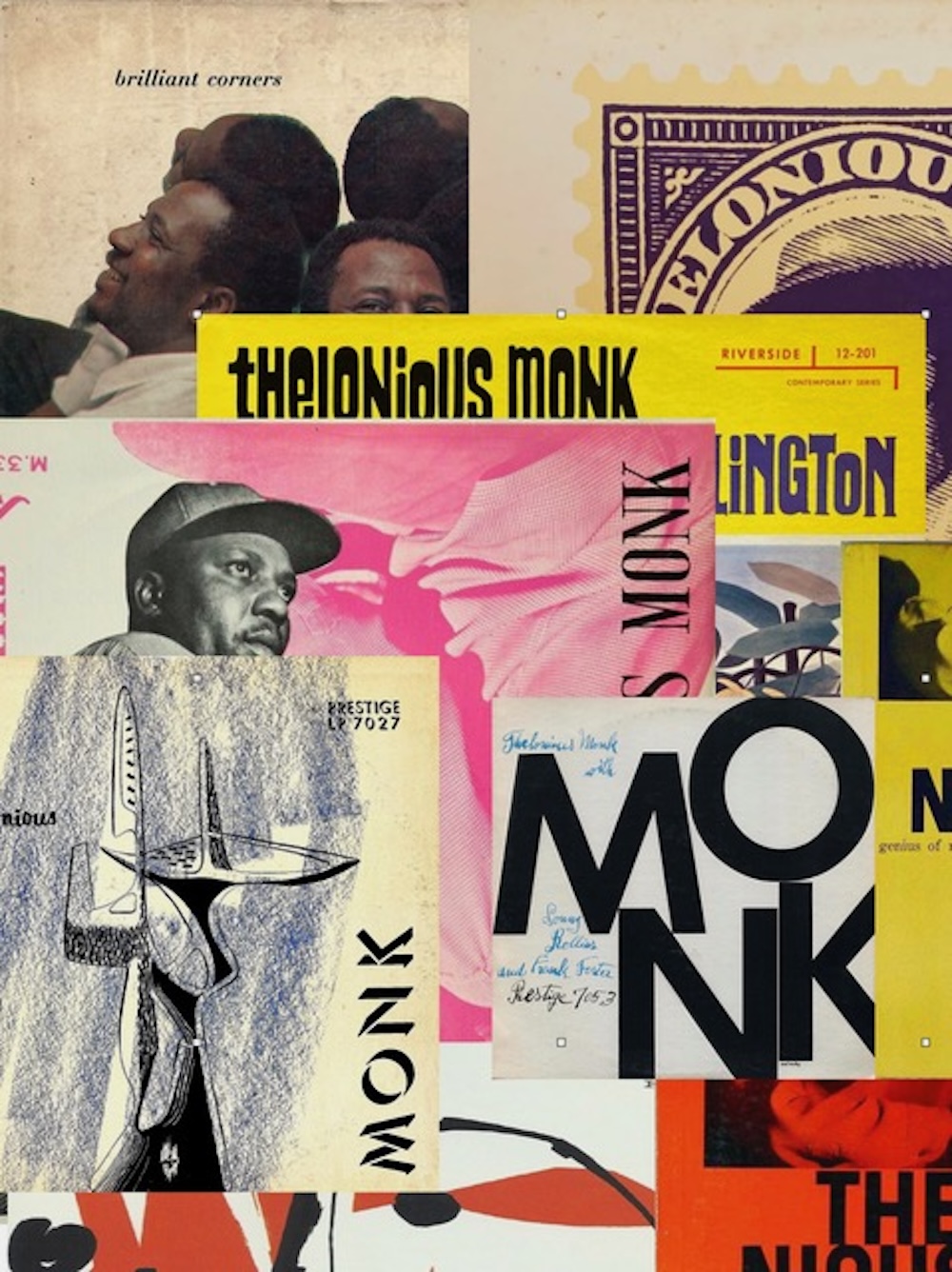







































.png)








